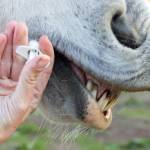New Research: The Changing Face of Parasitism in Horses

Advances in deworming over the last several decades have reduced the number of horses that perish from parasitism and its collateral damage, namely colic. Are horses still challenged by the same parasite species as 30 years ago? French scientists recently investigated this question using nearly 1,700 necropsy reports.1
As they reviewed the reports, the researchers loosely classified the burden of both strongylid and non-strongylid species in these horses.
Strongylid species, also known as redworms, were subdivided into large strongyles (Strongylidae subfamily) and small strongyles (Cyathostominae subfamily). Small strongyles are also referred to as cyathostomes. Important large strongyles included S. vulgaris, S. edentatus, and S. equinus, all of which migrate extensively through the body. Other species of large strongyles are less migratory. Nearly 50 species of cyathostomes affect horses, but only about 10 species were common. Non-strongylid species included Parascaris spp. (ascarids), Gasterophilus spp. (bots), and Anoplocephala spp. (tapeworms).
Researchers noted a marked change in the parasites responsible for fatal infections in the last two decades (from 2000 onward). They found a reduction in deaths caused by large strongyles, particularly S. vulgaris, and tapeworms, and an increase in fatalities due to small strongyles and ascarids.
Further, researchers observed that over one 10-year period (1998-2007) there was a rise in deaths attributed to ascarid infestation and a decline in deaths ascribed to bots and tapeworms.
The take-home message: certain non-strongylid parasites are becoming more prevalent as other parasites recede in significance.
How do horse owners detect and track parasite burdens? One way is through fecal egg counts (FEC), though not all horse owners take advantage of this test.
Surveys of European horse owners indicated that 50-60% of respondents routinely used FEC to assess parasite burden. In contrast, a 2015 study by the National Animal Health Monitoring Systems of horse owners in the U.S. indicated about 22% of respondents used FEC, suggesting little has changed since an earlier nationwide survey in 1998.2
Parasitism adversely affects the health of horses, sometimes to the point of death in the severest of cases. Prior to death, though, horses can withstand a considerable population of parasites, but this comes at a significant cost. Of note, parasitism can divert calories from growth and performance, so energy intended for the well-being of the horse is expended in supporting parasites. To avoid this, implement regular FEC in a parasite-management program and work with a veterinarian who is well-versed in deworming protocols.
Are you rehabbing a horse that is healing from parasitism? Contact a nutrition advisor at Kentucky Equine Research.
1Sallé, G., J. Guillot, J. Tapprest, N. Foucher, C. Sevin, and C. Laugier. 2020. Compilation of 29 years of postmortem examinations identifies major shifts in equine parasite prevalence from 2000 onwards. International Journal for Parasitology. In press.
2Nielsen, M.K., M.A. Branan, A.M. Wiedenheft, R. Digianantonio, L.P. Garber, C.A. Kopral, A.M. Phillippi-Taylor, and J.L. Traub-Dargatz. 2018. Parasite control strategies used by equine owners in the United States: A national survey. Veterinary Parasitology 250:45-51.








